Business Information Systems: Cost Leadership and Enterprise Systems
VerifiedAdded on 2022/08/15
|10
|2227
|81
Essay
AI Summary
This essay delves into the strategic approach of cost leadership within the context of business information systems (BIS). It begins by defining BIS and enterprise systems (ES) and explaining their role in achieving competitive advantage. The core focus is on how companies leverage ES to implement cost leadership strategies within their respective industry sectors. The essay supports its arguments with two detailed case studies: Walmart and McDonald's. The Walmart case study highlights how the company uses ES to maintain low prices and optimize its distribution network, while the McDonald's case study demonstrates how the fast-food chain utilizes ES to minimize costs, enhance product development efficiency, and create a competitive edge. The essay concludes by summarizing the benefits of ES and reinforcing the importance of cost leadership in today's competitive business landscape.
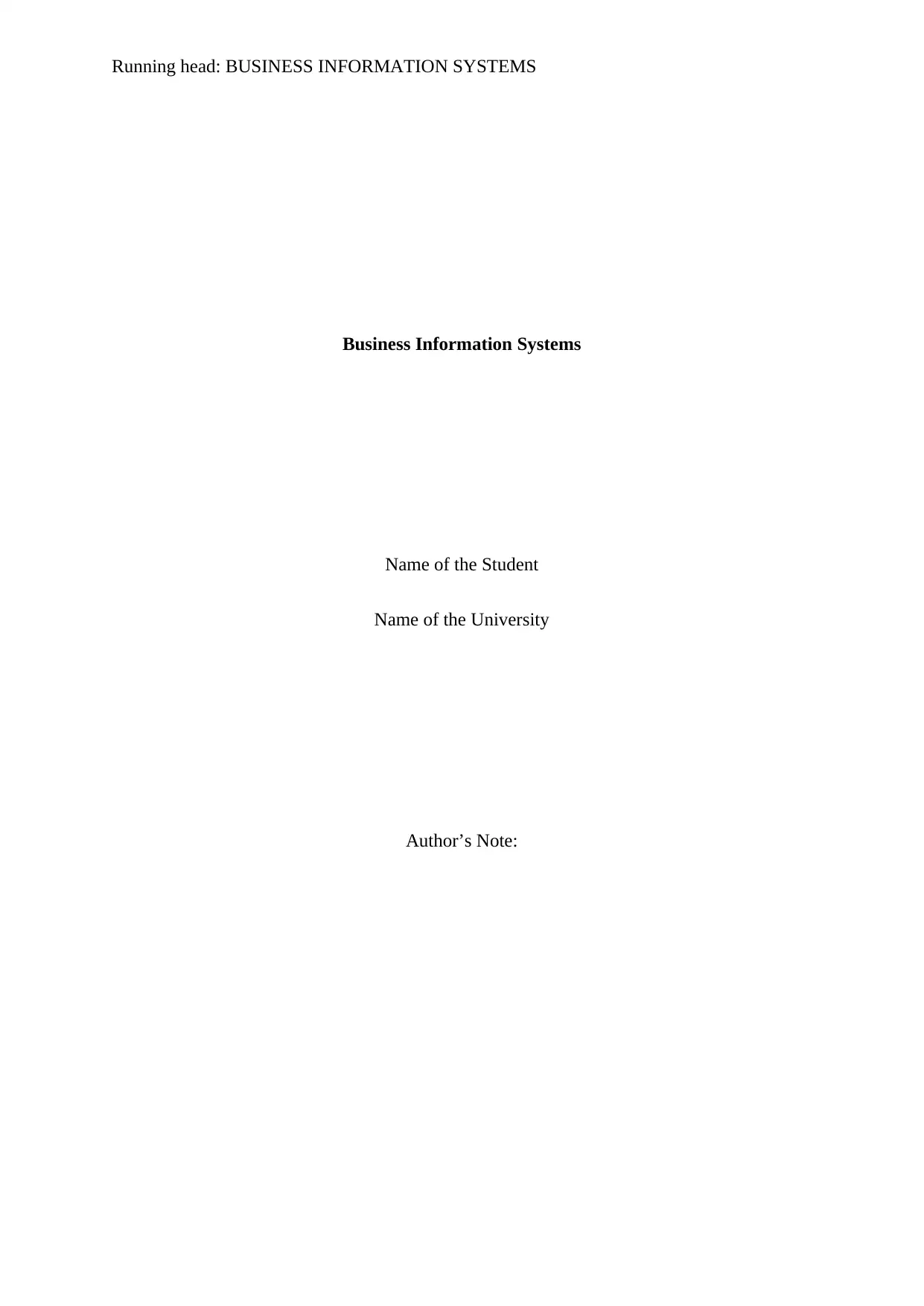
Running head: BUSINESS INFORMATION SYSTEMS
Business Information Systems
Name of the Student
Name of the University
Author’s Note:
Business Information Systems
Name of the Student
Name of the University
Author’s Note:
Secure Best Marks with AI Grader
Need help grading? Try our AI Grader for instant feedback on your assignments.
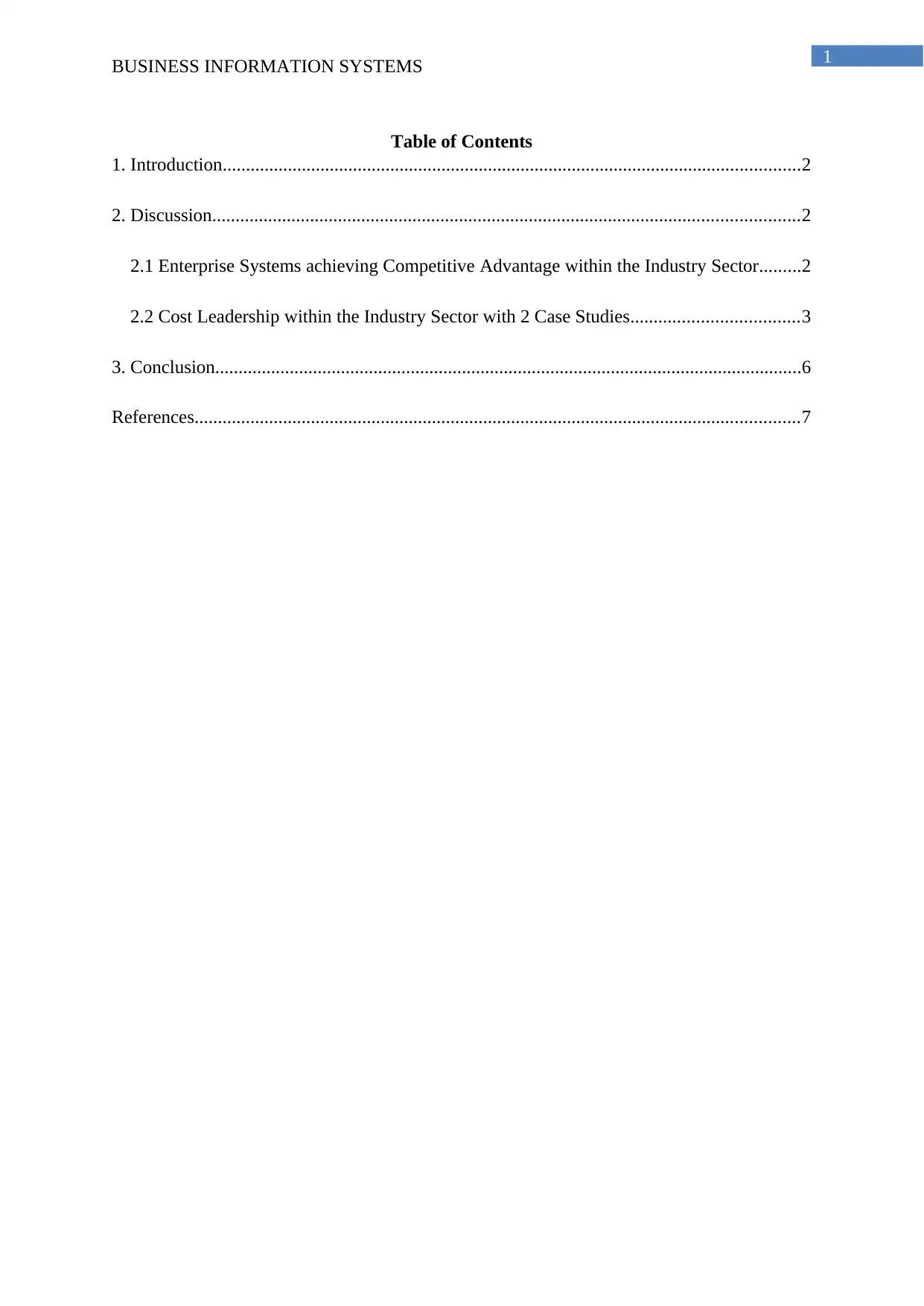
1
BUSINESS INFORMATION SYSTEMS
Table of Contents
1. Introduction............................................................................................................................2
2. Discussion..............................................................................................................................2
2.1 Enterprise Systems achieving Competitive Advantage within the Industry Sector.........2
2.2 Cost Leadership within the Industry Sector with 2 Case Studies....................................3
3. Conclusion..............................................................................................................................6
References..................................................................................................................................7
BUSINESS INFORMATION SYSTEMS
Table of Contents
1. Introduction............................................................................................................................2
2. Discussion..............................................................................................................................2
2.1 Enterprise Systems achieving Competitive Advantage within the Industry Sector.........2
2.2 Cost Leadership within the Industry Sector with 2 Case Studies....................................3
3. Conclusion..............................................................................................................................6
References..................................................................................................................................7
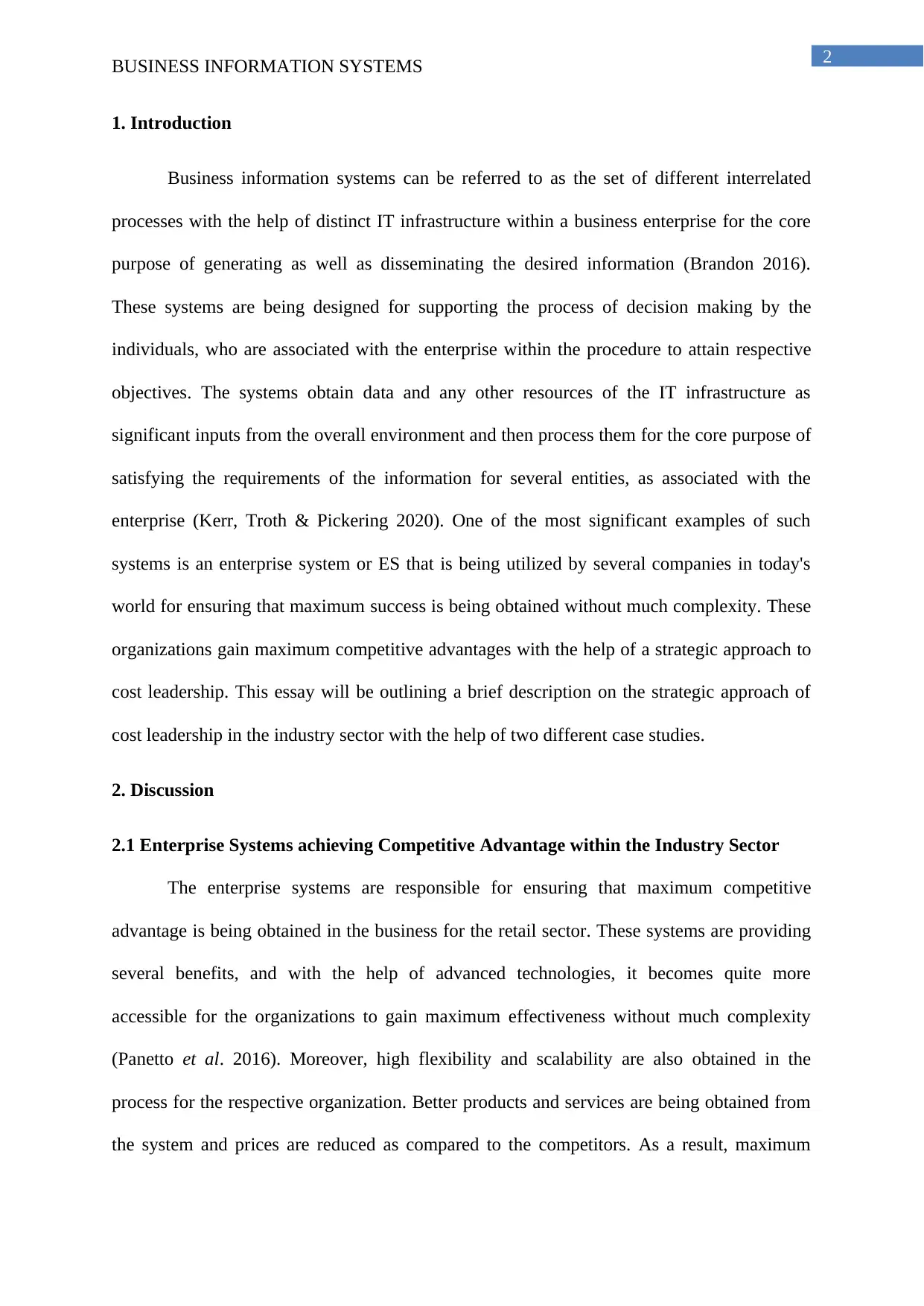
2
BUSINESS INFORMATION SYSTEMS
1. Introduction
Business information systems can be referred to as the set of different interrelated
processes with the help of distinct IT infrastructure within a business enterprise for the core
purpose of generating as well as disseminating the desired information (Brandon 2016).
These systems are being designed for supporting the process of decision making by the
individuals, who are associated with the enterprise within the procedure to attain respective
objectives. The systems obtain data and any other resources of the IT infrastructure as
significant inputs from the overall environment and then process them for the core purpose of
satisfying the requirements of the information for several entities, as associated with the
enterprise (Kerr, Troth & Pickering 2020). One of the most significant examples of such
systems is an enterprise system or ES that is being utilized by several companies in today's
world for ensuring that maximum success is being obtained without much complexity. These
organizations gain maximum competitive advantages with the help of a strategic approach to
cost leadership. This essay will be outlining a brief description on the strategic approach of
cost leadership in the industry sector with the help of two different case studies.
2. Discussion
2.1 Enterprise Systems achieving Competitive Advantage within the Industry Sector
The enterprise systems are responsible for ensuring that maximum competitive
advantage is being obtained in the business for the retail sector. These systems are providing
several benefits, and with the help of advanced technologies, it becomes quite more
accessible for the organizations to gain maximum effectiveness without much complexity
(Panetto et al. 2016). Moreover, high flexibility and scalability are also obtained in the
process for the respective organization. Better products and services are being obtained from
the system and prices are reduced as compared to the competitors. As a result, maximum
BUSINESS INFORMATION SYSTEMS
1. Introduction
Business information systems can be referred to as the set of different interrelated
processes with the help of distinct IT infrastructure within a business enterprise for the core
purpose of generating as well as disseminating the desired information (Brandon 2016).
These systems are being designed for supporting the process of decision making by the
individuals, who are associated with the enterprise within the procedure to attain respective
objectives. The systems obtain data and any other resources of the IT infrastructure as
significant inputs from the overall environment and then process them for the core purpose of
satisfying the requirements of the information for several entities, as associated with the
enterprise (Kerr, Troth & Pickering 2020). One of the most significant examples of such
systems is an enterprise system or ES that is being utilized by several companies in today's
world for ensuring that maximum success is being obtained without much complexity. These
organizations gain maximum competitive advantages with the help of a strategic approach to
cost leadership. This essay will be outlining a brief description on the strategic approach of
cost leadership in the industry sector with the help of two different case studies.
2. Discussion
2.1 Enterprise Systems achieving Competitive Advantage within the Industry Sector
The enterprise systems are responsible for ensuring that maximum competitive
advantage is being obtained in the business for the retail sector. These systems are providing
several benefits, and with the help of advanced technologies, it becomes quite more
accessible for the organizations to gain maximum effectiveness without much complexity
(Panetto et al. 2016). Moreover, high flexibility and scalability are also obtained in the
process for the respective organization. Better products and services are being obtained from
the system and prices are reduced as compared to the competitors. As a result, maximum
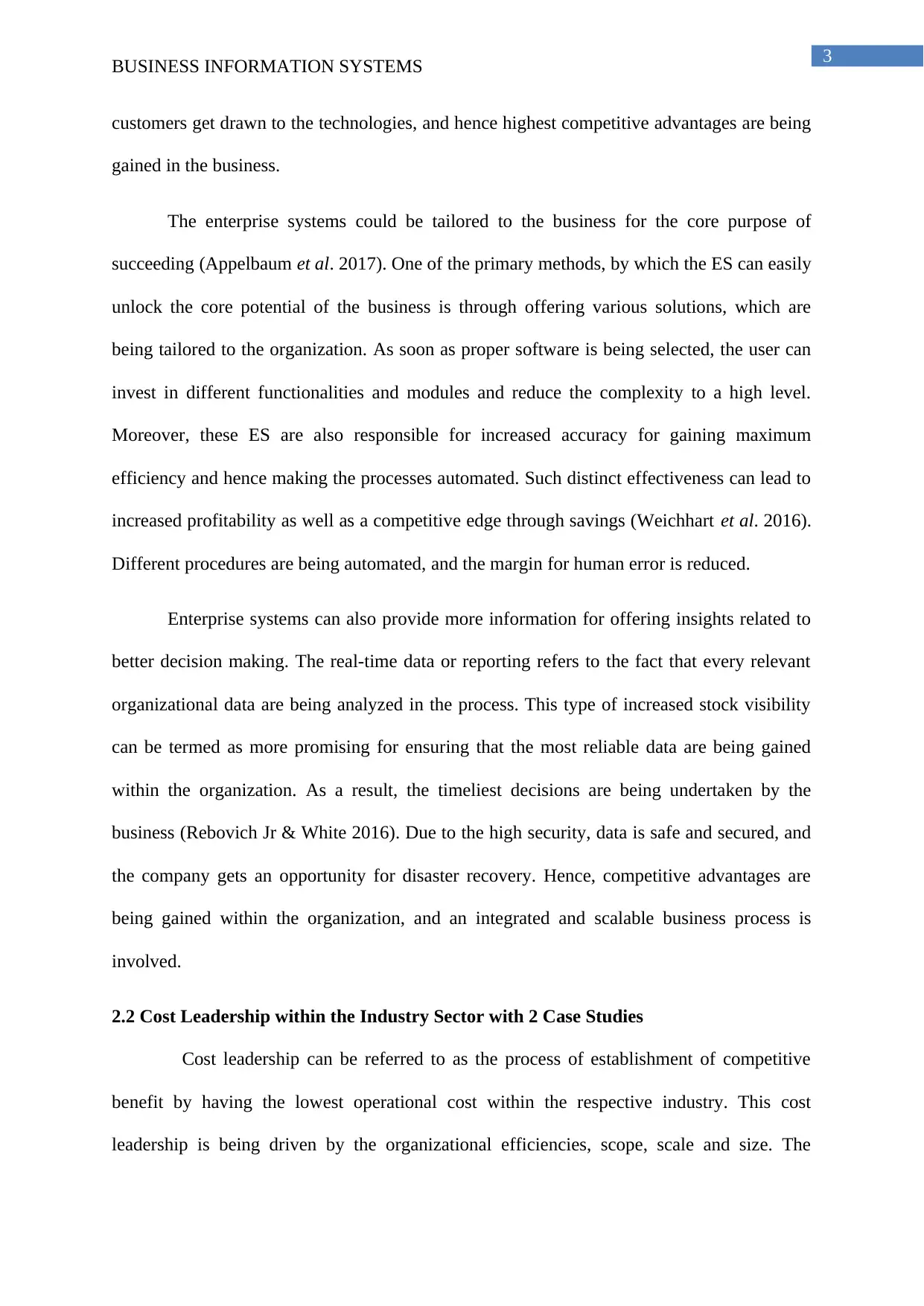
3
BUSINESS INFORMATION SYSTEMS
customers get drawn to the technologies, and hence highest competitive advantages are being
gained in the business.
The enterprise systems could be tailored to the business for the core purpose of
succeeding (Appelbaum et al. 2017). One of the primary methods, by which the ES can easily
unlock the core potential of the business is through offering various solutions, which are
being tailored to the organization. As soon as proper software is being selected, the user can
invest in different functionalities and modules and reduce the complexity to a high level.
Moreover, these ES are also responsible for increased accuracy for gaining maximum
efficiency and hence making the processes automated. Such distinct effectiveness can lead to
increased profitability as well as a competitive edge through savings (Weichhart et al. 2016).
Different procedures are being automated, and the margin for human error is reduced.
Enterprise systems can also provide more information for offering insights related to
better decision making. The real-time data or reporting refers to the fact that every relevant
organizational data are being analyzed in the process. This type of increased stock visibility
can be termed as more promising for ensuring that the most reliable data are being gained
within the organization. As a result, the timeliest decisions are being undertaken by the
business (Rebovich Jr & White 2016). Due to the high security, data is safe and secured, and
the company gets an opportunity for disaster recovery. Hence, competitive advantages are
being gained within the organization, and an integrated and scalable business process is
involved.
2.2 Cost Leadership within the Industry Sector with 2 Case Studies
Cost leadership can be referred to as the process of establishment of competitive
benefit by having the lowest operational cost within the respective industry. This cost
leadership is being driven by the organizational efficiencies, scope, scale and size. The
BUSINESS INFORMATION SYSTEMS
customers get drawn to the technologies, and hence highest competitive advantages are being
gained in the business.
The enterprise systems could be tailored to the business for the core purpose of
succeeding (Appelbaum et al. 2017). One of the primary methods, by which the ES can easily
unlock the core potential of the business is through offering various solutions, which are
being tailored to the organization. As soon as proper software is being selected, the user can
invest in different functionalities and modules and reduce the complexity to a high level.
Moreover, these ES are also responsible for increased accuracy for gaining maximum
efficiency and hence making the processes automated. Such distinct effectiveness can lead to
increased profitability as well as a competitive edge through savings (Weichhart et al. 2016).
Different procedures are being automated, and the margin for human error is reduced.
Enterprise systems can also provide more information for offering insights related to
better decision making. The real-time data or reporting refers to the fact that every relevant
organizational data are being analyzed in the process. This type of increased stock visibility
can be termed as more promising for ensuring that the most reliable data are being gained
within the organization. As a result, the timeliest decisions are being undertaken by the
business (Rebovich Jr & White 2016). Due to the high security, data is safe and secured, and
the company gets an opportunity for disaster recovery. Hence, competitive advantages are
being gained within the organization, and an integrated and scalable business process is
involved.
2.2 Cost Leadership within the Industry Sector with 2 Case Studies
Cost leadership can be referred to as the process of establishment of competitive
benefit by having the lowest operational cost within the respective industry. This cost
leadership is being driven by the organizational efficiencies, scope, scale and size. The
Secure Best Marks with AI Grader
Need help grading? Try our AI Grader for instant feedback on your assignments.
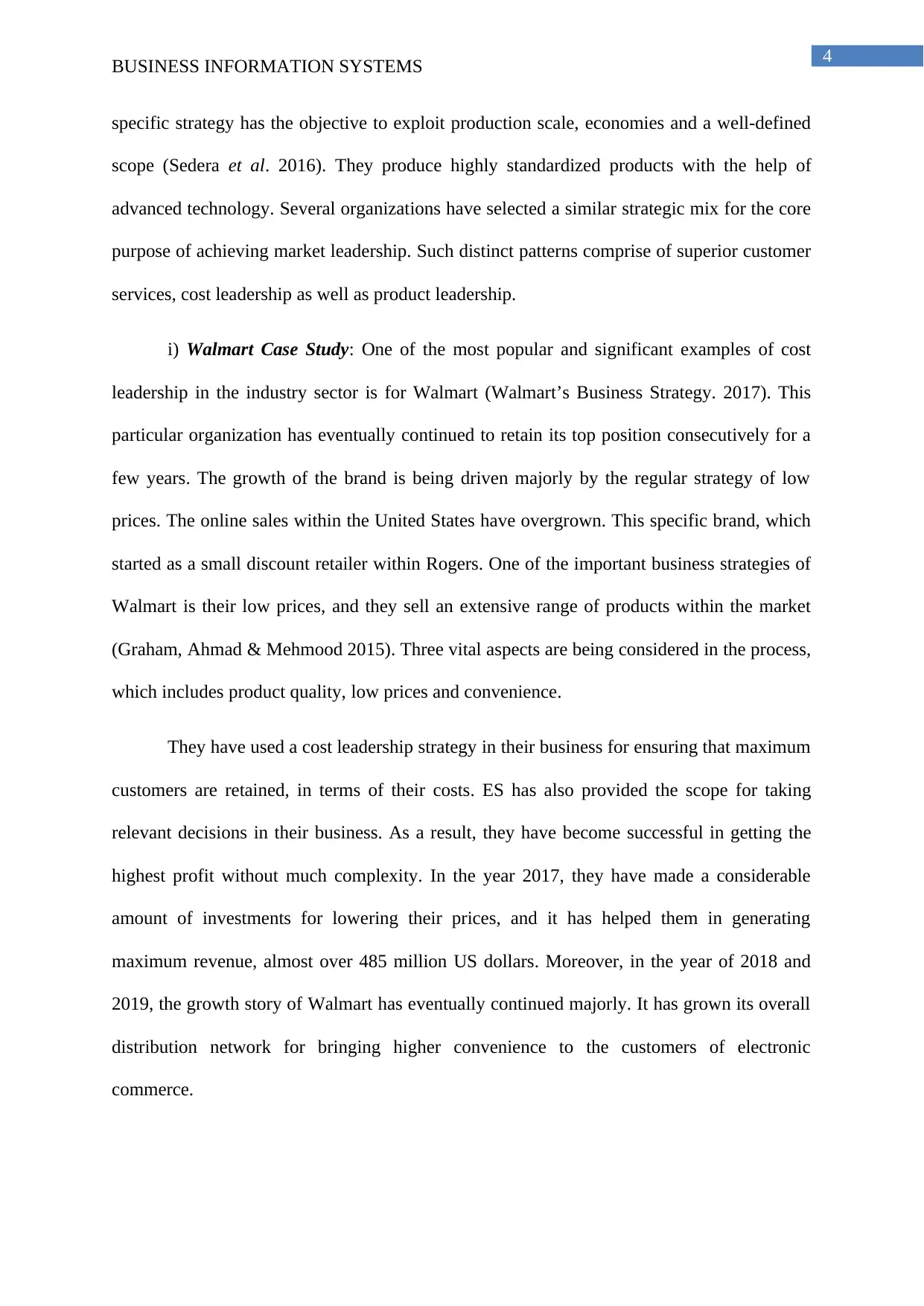
4
BUSINESS INFORMATION SYSTEMS
specific strategy has the objective to exploit production scale, economies and a well-defined
scope (Sedera et al. 2016). They produce highly standardized products with the help of
advanced technology. Several organizations have selected a similar strategic mix for the core
purpose of achieving market leadership. Such distinct patterns comprise of superior customer
services, cost leadership as well as product leadership.
i) Walmart Case Study: One of the most popular and significant examples of cost
leadership in the industry sector is for Walmart (Walmart’s Business Strategy. 2017). This
particular organization has eventually continued to retain its top position consecutively for a
few years. The growth of the brand is being driven majorly by the regular strategy of low
prices. The online sales within the United States have overgrown. This specific brand, which
started as a small discount retailer within Rogers. One of the important business strategies of
Walmart is their low prices, and they sell an extensive range of products within the market
(Graham, Ahmad & Mehmood 2015). Three vital aspects are being considered in the process,
which includes product quality, low prices and convenience.
They have used a cost leadership strategy in their business for ensuring that maximum
customers are retained, in terms of their costs. ES has also provided the scope for taking
relevant decisions in their business. As a result, they have become successful in getting the
highest profit without much complexity. In the year 2017, they have made a considerable
amount of investments for lowering their prices, and it has helped them in generating
maximum revenue, almost over 485 million US dollars. Moreover, in the year of 2018 and
2019, the growth story of Walmart has eventually continued majorly. It has grown its overall
distribution network for bringing higher convenience to the customers of electronic
commerce.
BUSINESS INFORMATION SYSTEMS
specific strategy has the objective to exploit production scale, economies and a well-defined
scope (Sedera et al. 2016). They produce highly standardized products with the help of
advanced technology. Several organizations have selected a similar strategic mix for the core
purpose of achieving market leadership. Such distinct patterns comprise of superior customer
services, cost leadership as well as product leadership.
i) Walmart Case Study: One of the most popular and significant examples of cost
leadership in the industry sector is for Walmart (Walmart’s Business Strategy. 2017). This
particular organization has eventually continued to retain its top position consecutively for a
few years. The growth of the brand is being driven majorly by the regular strategy of low
prices. The online sales within the United States have overgrown. This specific brand, which
started as a small discount retailer within Rogers. One of the important business strategies of
Walmart is their low prices, and they sell an extensive range of products within the market
(Graham, Ahmad & Mehmood 2015). Three vital aspects are being considered in the process,
which includes product quality, low prices and convenience.
They have used a cost leadership strategy in their business for ensuring that maximum
customers are retained, in terms of their costs. ES has also provided the scope for taking
relevant decisions in their business. As a result, they have become successful in getting the
highest profit without much complexity. In the year 2017, they have made a considerable
amount of investments for lowering their prices, and it has helped them in generating
maximum revenue, almost over 485 million US dollars. Moreover, in the year of 2018 and
2019, the growth story of Walmart has eventually continued majorly. It has grown its overall
distribution network for bringing higher convenience to the customers of electronic
commerce.
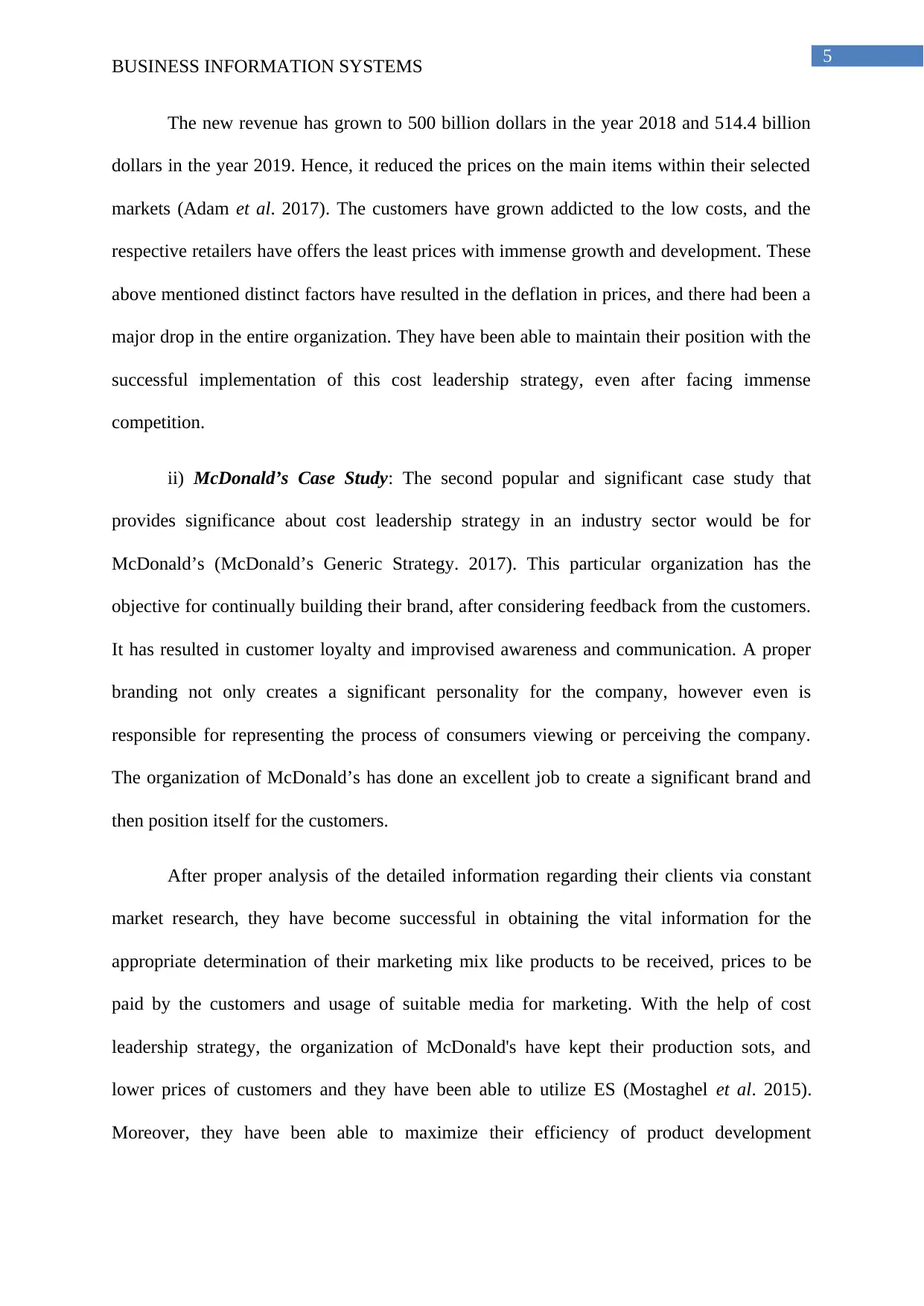
5
BUSINESS INFORMATION SYSTEMS
The new revenue has grown to 500 billion dollars in the year 2018 and 514.4 billion
dollars in the year 2019. Hence, it reduced the prices on the main items within their selected
markets (Adam et al. 2017). The customers have grown addicted to the low costs, and the
respective retailers have offers the least prices with immense growth and development. These
above mentioned distinct factors have resulted in the deflation in prices, and there had been a
major drop in the entire organization. They have been able to maintain their position with the
successful implementation of this cost leadership strategy, even after facing immense
competition.
ii) McDonald’s Case Study: The second popular and significant case study that
provides significance about cost leadership strategy in an industry sector would be for
McDonald’s (McDonald’s Generic Strategy. 2017). This particular organization has the
objective for continually building their brand, after considering feedback from the customers.
It has resulted in customer loyalty and improvised awareness and communication. A proper
branding not only creates a significant personality for the company, however even is
responsible for representing the process of consumers viewing or perceiving the company.
The organization of McDonald’s has done an excellent job to create a significant brand and
then position itself for the customers.
After proper analysis of the detailed information regarding their clients via constant
market research, they have become successful in obtaining the vital information for the
appropriate determination of their marketing mix like products to be received, prices to be
paid by the customers and usage of suitable media for marketing. With the help of cost
leadership strategy, the organization of McDonald's have kept their production sots, and
lower prices of customers and they have been able to utilize ES (Mostaghel et al. 2015).
Moreover, they have been able to maximize their efficiency of product development
BUSINESS INFORMATION SYSTEMS
The new revenue has grown to 500 billion dollars in the year 2018 and 514.4 billion
dollars in the year 2019. Hence, it reduced the prices on the main items within their selected
markets (Adam et al. 2017). The customers have grown addicted to the low costs, and the
respective retailers have offers the least prices with immense growth and development. These
above mentioned distinct factors have resulted in the deflation in prices, and there had been a
major drop in the entire organization. They have been able to maintain their position with the
successful implementation of this cost leadership strategy, even after facing immense
competition.
ii) McDonald’s Case Study: The second popular and significant case study that
provides significance about cost leadership strategy in an industry sector would be for
McDonald’s (McDonald’s Generic Strategy. 2017). This particular organization has the
objective for continually building their brand, after considering feedback from the customers.
It has resulted in customer loyalty and improvised awareness and communication. A proper
branding not only creates a significant personality for the company, however even is
responsible for representing the process of consumers viewing or perceiving the company.
The organization of McDonald’s has done an excellent job to create a significant brand and
then position itself for the customers.
After proper analysis of the detailed information regarding their clients via constant
market research, they have become successful in obtaining the vital information for the
appropriate determination of their marketing mix like products to be received, prices to be
paid by the customers and usage of suitable media for marketing. With the help of cost
leadership strategy, the organization of McDonald's have kept their production sots, and
lower prices of customers and they have been able to utilize ES (Mostaghel et al. 2015).
Moreover, they have been able to maximize their efficiency of product development
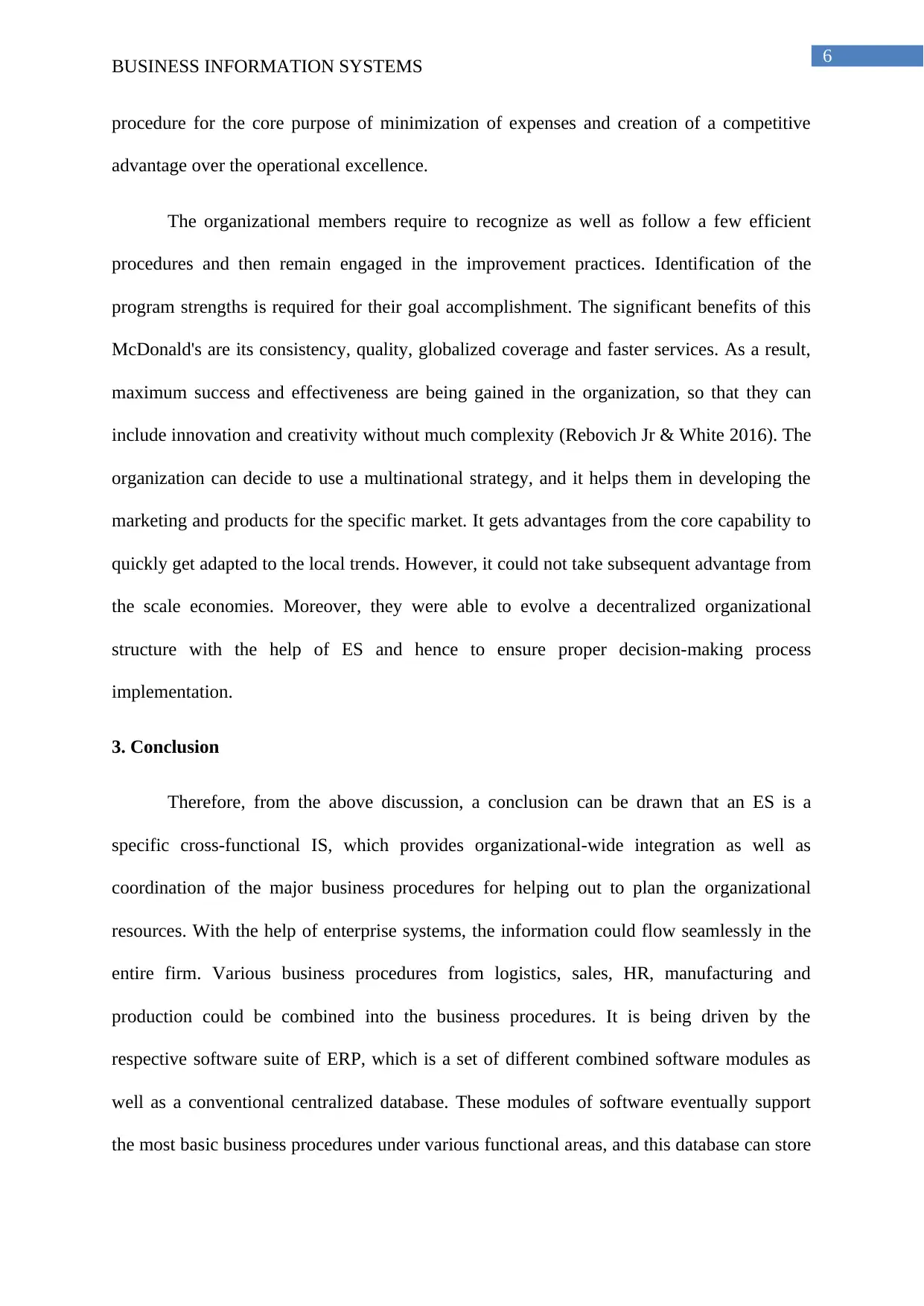
6
BUSINESS INFORMATION SYSTEMS
procedure for the core purpose of minimization of expenses and creation of a competitive
advantage over the operational excellence.
The organizational members require to recognize as well as follow a few efficient
procedures and then remain engaged in the improvement practices. Identification of the
program strengths is required for their goal accomplishment. The significant benefits of this
McDonald's are its consistency, quality, globalized coverage and faster services. As a result,
maximum success and effectiveness are being gained in the organization, so that they can
include innovation and creativity without much complexity (Rebovich Jr & White 2016). The
organization can decide to use a multinational strategy, and it helps them in developing the
marketing and products for the specific market. It gets advantages from the core capability to
quickly get adapted to the local trends. However, it could not take subsequent advantage from
the scale economies. Moreover, they were able to evolve a decentralized organizational
structure with the help of ES and hence to ensure proper decision-making process
implementation.
3. Conclusion
Therefore, from the above discussion, a conclusion can be drawn that an ES is a
specific cross-functional IS, which provides organizational-wide integration as well as
coordination of the major business procedures for helping out to plan the organizational
resources. With the help of enterprise systems, the information could flow seamlessly in the
entire firm. Various business procedures from logistics, sales, HR, manufacturing and
production could be combined into the business procedures. It is being driven by the
respective software suite of ERP, which is a set of different combined software modules as
well as a conventional centralized database. These modules of software eventually support
the most basic business procedures under various functional areas, and this database can store
BUSINESS INFORMATION SYSTEMS
procedure for the core purpose of minimization of expenses and creation of a competitive
advantage over the operational excellence.
The organizational members require to recognize as well as follow a few efficient
procedures and then remain engaged in the improvement practices. Identification of the
program strengths is required for their goal accomplishment. The significant benefits of this
McDonald's are its consistency, quality, globalized coverage and faster services. As a result,
maximum success and effectiveness are being gained in the organization, so that they can
include innovation and creativity without much complexity (Rebovich Jr & White 2016). The
organization can decide to use a multinational strategy, and it helps them in developing the
marketing and products for the specific market. It gets advantages from the core capability to
quickly get adapted to the local trends. However, it could not take subsequent advantage from
the scale economies. Moreover, they were able to evolve a decentralized organizational
structure with the help of ES and hence to ensure proper decision-making process
implementation.
3. Conclusion
Therefore, from the above discussion, a conclusion can be drawn that an ES is a
specific cross-functional IS, which provides organizational-wide integration as well as
coordination of the major business procedures for helping out to plan the organizational
resources. With the help of enterprise systems, the information could flow seamlessly in the
entire firm. Various business procedures from logistics, sales, HR, manufacturing and
production could be combined into the business procedures. It is being driven by the
respective software suite of ERP, which is a set of different combined software modules as
well as a conventional centralized database. These modules of software eventually support
the most basic business procedures under various functional areas, and this database can store
Paraphrase This Document
Need a fresh take? Get an instant paraphrase of this document with our AI Paraphraser
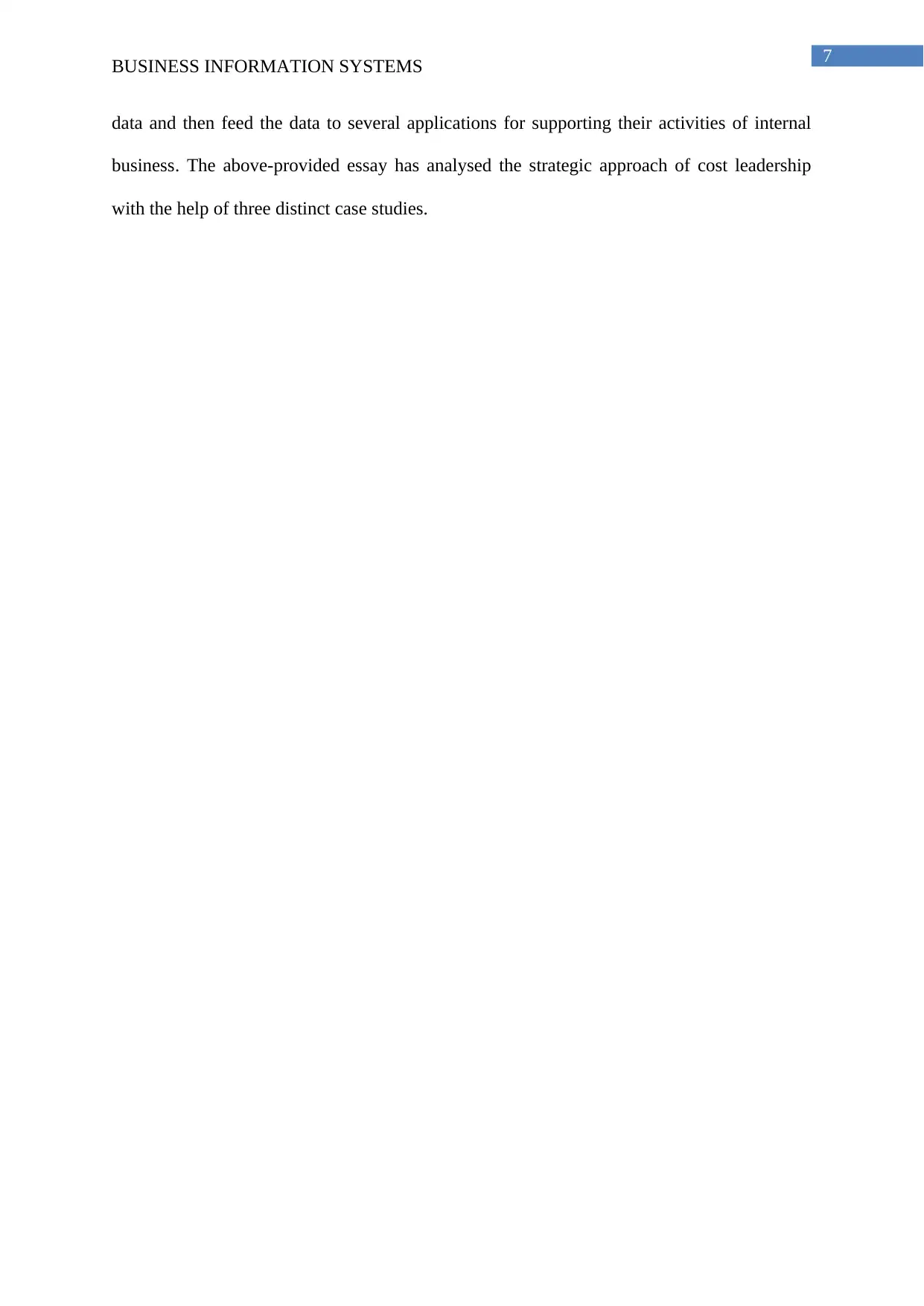
7
BUSINESS INFORMATION SYSTEMS
data and then feed the data to several applications for supporting their activities of internal
business. The above-provided essay has analysed the strategic approach of cost leadership
with the help of three distinct case studies.
BUSINESS INFORMATION SYSTEMS
data and then feed the data to several applications for supporting their activities of internal
business. The above-provided essay has analysed the strategic approach of cost leadership
with the help of three distinct case studies.
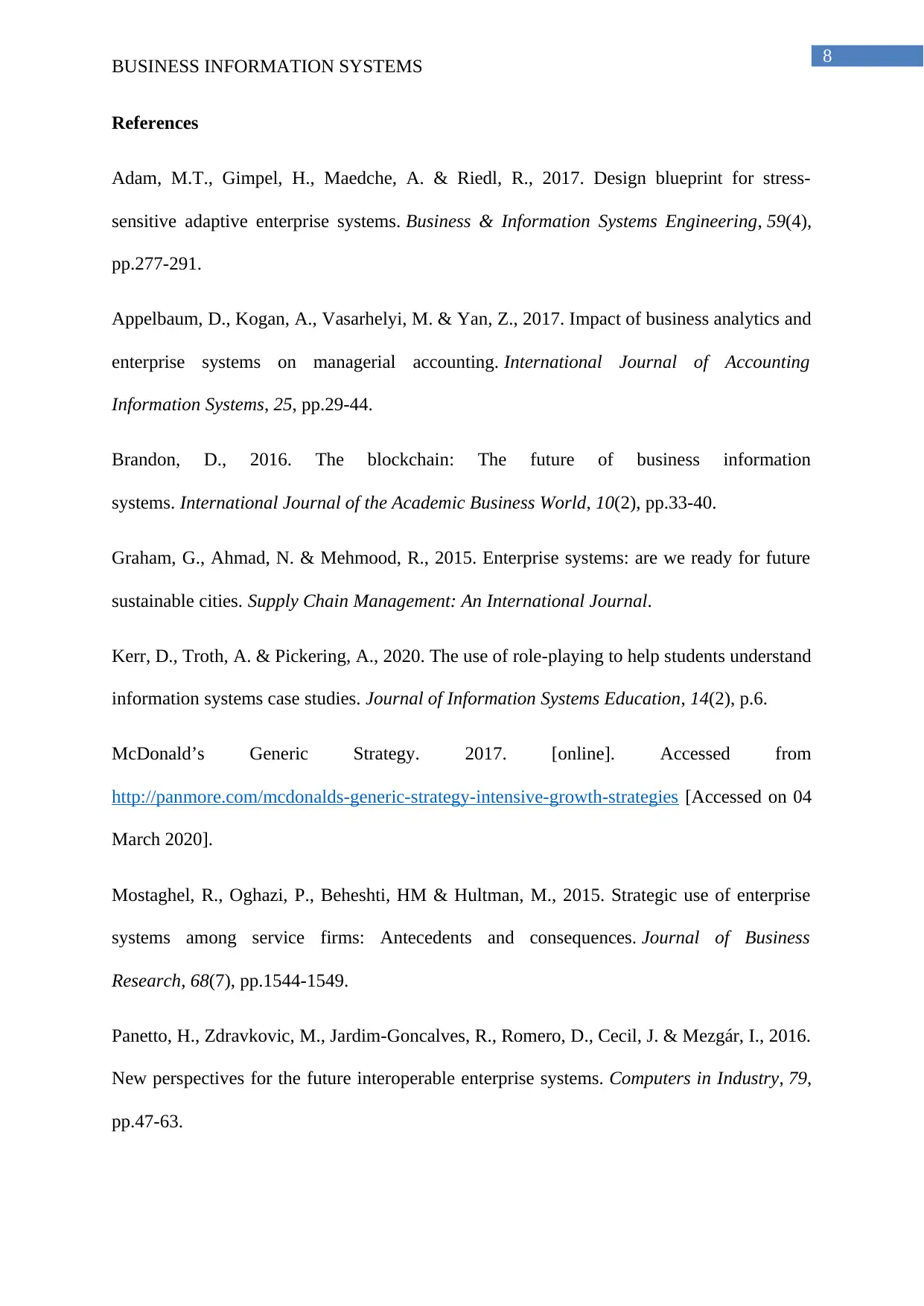
8
BUSINESS INFORMATION SYSTEMS
References
Adam, M.T., Gimpel, H., Maedche, A. & Riedl, R., 2017. Design blueprint for stress-
sensitive adaptive enterprise systems. Business & Information Systems Engineering, 59(4),
pp.277-291.
Appelbaum, D., Kogan, A., Vasarhelyi, M. & Yan, Z., 2017. Impact of business analytics and
enterprise systems on managerial accounting. International Journal of Accounting
Information Systems, 25, pp.29-44.
Brandon, D., 2016. The blockchain: The future of business information
systems. International Journal of the Academic Business World, 10(2), pp.33-40.
Graham, G., Ahmad, N. & Mehmood, R., 2015. Enterprise systems: are we ready for future
sustainable cities. Supply Chain Management: An International Journal.
Kerr, D., Troth, A. & Pickering, A., 2020. The use of role-playing to help students understand
information systems case studies. Journal of Information Systems Education, 14(2), p.6.
McDonald’s Generic Strategy. 2017. [online]. Accessed from
http://panmore.com/mcdonalds-generic-strategy-intensive-growth-strategies [Accessed on 04
March 2020].
Mostaghel, R., Oghazi, P., Beheshti, HM & Hultman, M., 2015. Strategic use of enterprise
systems among service firms: Antecedents and consequences. Journal of Business
Research, 68(7), pp.1544-1549.
Panetto, H., Zdravkovic, M., Jardim-Goncalves, R., Romero, D., Cecil, J. & Mezgár, I., 2016.
New perspectives for the future interoperable enterprise systems. Computers in Industry, 79,
pp.47-63.
BUSINESS INFORMATION SYSTEMS
References
Adam, M.T., Gimpel, H., Maedche, A. & Riedl, R., 2017. Design blueprint for stress-
sensitive adaptive enterprise systems. Business & Information Systems Engineering, 59(4),
pp.277-291.
Appelbaum, D., Kogan, A., Vasarhelyi, M. & Yan, Z., 2017. Impact of business analytics and
enterprise systems on managerial accounting. International Journal of Accounting
Information Systems, 25, pp.29-44.
Brandon, D., 2016. The blockchain: The future of business information
systems. International Journal of the Academic Business World, 10(2), pp.33-40.
Graham, G., Ahmad, N. & Mehmood, R., 2015. Enterprise systems: are we ready for future
sustainable cities. Supply Chain Management: An International Journal.
Kerr, D., Troth, A. & Pickering, A., 2020. The use of role-playing to help students understand
information systems case studies. Journal of Information Systems Education, 14(2), p.6.
McDonald’s Generic Strategy. 2017. [online]. Accessed from
http://panmore.com/mcdonalds-generic-strategy-intensive-growth-strategies [Accessed on 04
March 2020].
Mostaghel, R., Oghazi, P., Beheshti, HM & Hultman, M., 2015. Strategic use of enterprise
systems among service firms: Antecedents and consequences. Journal of Business
Research, 68(7), pp.1544-1549.
Panetto, H., Zdravkovic, M., Jardim-Goncalves, R., Romero, D., Cecil, J. & Mezgár, I., 2016.
New perspectives for the future interoperable enterprise systems. Computers in Industry, 79,
pp.47-63.
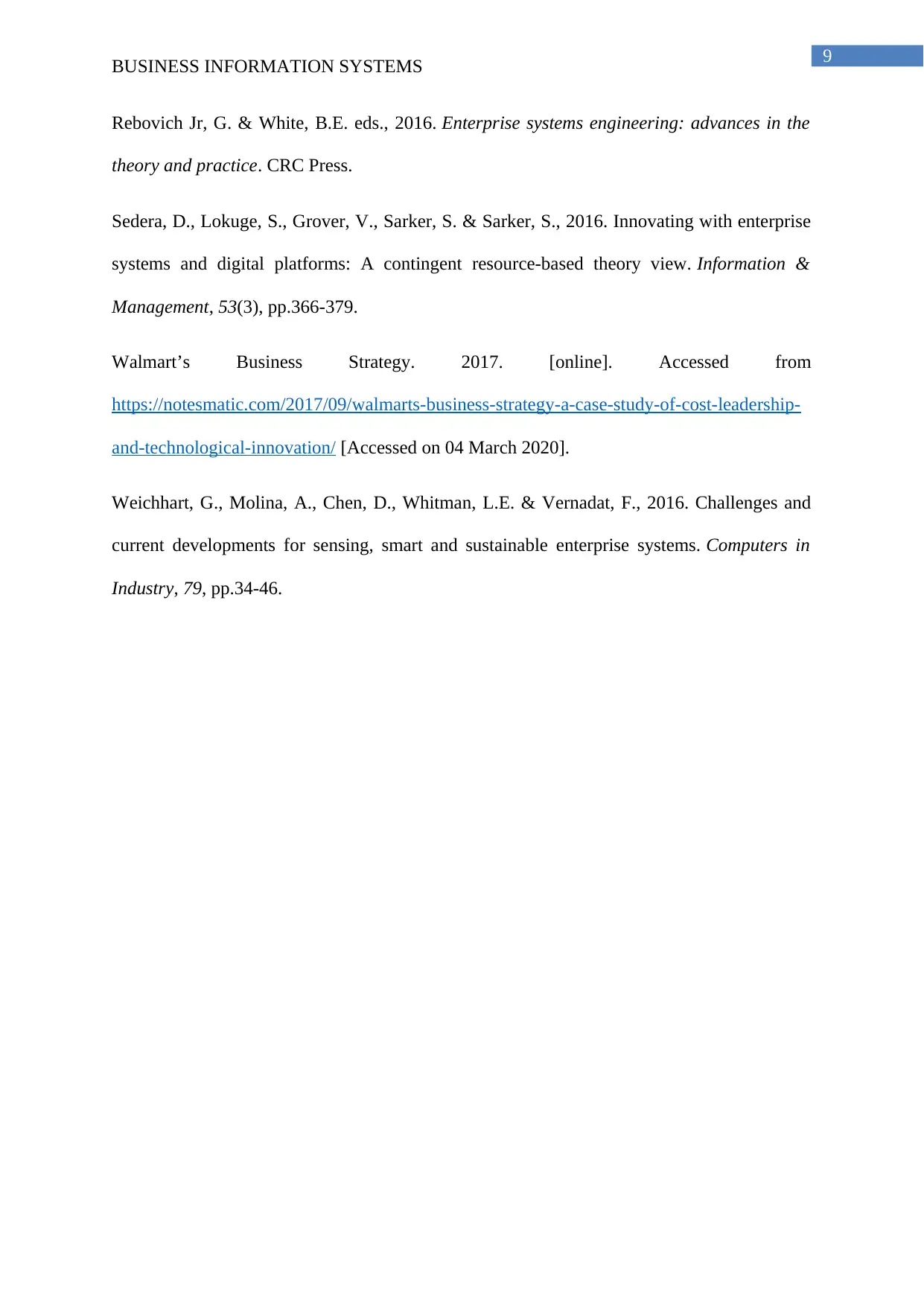
9
BUSINESS INFORMATION SYSTEMS
Rebovich Jr, G. & White, B.E. eds., 2016. Enterprise systems engineering: advances in the
theory and practice. CRC Press.
Sedera, D., Lokuge, S., Grover, V., Sarker, S. & Sarker, S., 2016. Innovating with enterprise
systems and digital platforms: A contingent resource-based theory view. Information &
Management, 53(3), pp.366-379.
Walmart’s Business Strategy. 2017. [online]. Accessed from
https://notesmatic.com/2017/09/walmarts-business-strategy-a-case-study-of-cost-leadership-
and-technological-innovation/ [Accessed on 04 March 2020].
Weichhart, G., Molina, A., Chen, D., Whitman, L.E. & Vernadat, F., 2016. Challenges and
current developments for sensing, smart and sustainable enterprise systems. Computers in
Industry, 79, pp.34-46.
BUSINESS INFORMATION SYSTEMS
Rebovich Jr, G. & White, B.E. eds., 2016. Enterprise systems engineering: advances in the
theory and practice. CRC Press.
Sedera, D., Lokuge, S., Grover, V., Sarker, S. & Sarker, S., 2016. Innovating with enterprise
systems and digital platforms: A contingent resource-based theory view. Information &
Management, 53(3), pp.366-379.
Walmart’s Business Strategy. 2017. [online]. Accessed from
https://notesmatic.com/2017/09/walmarts-business-strategy-a-case-study-of-cost-leadership-
and-technological-innovation/ [Accessed on 04 March 2020].
Weichhart, G., Molina, A., Chen, D., Whitman, L.E. & Vernadat, F., 2016. Challenges and
current developments for sensing, smart and sustainable enterprise systems. Computers in
Industry, 79, pp.34-46.
1 out of 10
Related Documents
Your All-in-One AI-Powered Toolkit for Academic Success.
+13062052269
info@desklib.com
Available 24*7 on WhatsApp / Email
![[object Object]](/_next/static/media/star-bottom.7253800d.svg)
Unlock your academic potential
© 2024 | Zucol Services PVT LTD | All rights reserved.





